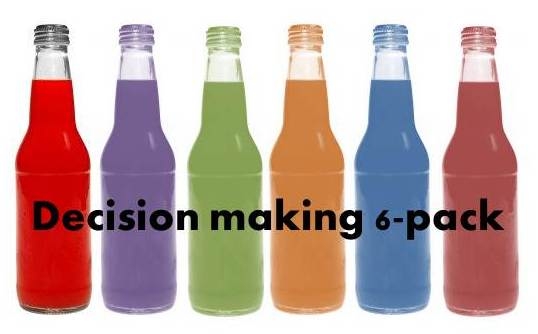 “It’s official. My boss is a jerk. He told me this morning he thinks my decision to go with a new printing vendor was bad.”
“It’s official. My boss is a jerk. He told me this morning he thinks my decision to go with a new printing vendor was bad.”
“Did he give you a reason for feeling that way?”
“He says it’s going to create problems for the marketing team and that I should have talked to them.”
“You did talk to them, didn’t you?”
“No. The new folks offered me a great deal. I saw an opportunity to save money and took it. He should be happy, not beating me up about it.”
Danger signs at the intersection of autonomy and collaboration!
In Motivation, Daniel Pink shares research detailing — not surprisingly — that we’re stimulated by purpose, mastery and autonomy. Yet, if our goal is being a successful leader, we must balance the autonomy portion of that equation with collaboration.
A 6-part decision-making process
Sometimes a party of one is the best decision-maker; other times, achieving workable and productive outcomes requires involving others to drive diversity of thought, buy-in and participation. When this is so, here’s a simple decision-making process to use to assure involvement and a rich, thoughtful outcome:
- Be inclusive in your data gathering. Conduct a focus group, chat over coffee, mingle after the staff meeting — all good locales for sharing and testing your preliminary thoughts and inviting alternate points of view.
- Generate and explore other solutions. No doubt that solving problems is a big part of your job. Just be sure you’ve read enough, talked enough, and turned over enough rocks to have a full picture of both the problem and potential solutions. Sometimes you find out the problem you’re trying to solve isn’t the problem at all. As you explore, challenge (in a positive, professional way, of course!) the thinking of those involved. Healthy debate is integral to determining the right solution.
- Select the best outcome. Be thoughtful in analyzing pros and cons. Ferret out unintended consequences before they happen. Balance the three-legged stool of people, principles and profits.
- Double-check your decision. Bounce the problem and proposed solution off an impartial third-party. Get a truly unbiased view of whether your solution is on the mark or misses it. Park the ego, and be willing to return to square one based on what you learn.
- Communicate and communicate some more. Double-back with stakeholders (at all levels within the organization) to assure their buy-in. Talk to people who will be impacted by the new system, process, policy, etc. and weigh their feedback. Play angel’s advocate with yourself and with the decision-making team to test assumptions and solutions to see if they hold water.
- Make it so. Implement the change, create success measures (both quantitative and qualitative as appropriate) and use a thoughtful plan to monitor progress and maintain ongoing communications.
Once you’ve followed this process, then you can say “I’ve done my job!”

Outstanding post! Daresay every hurdle I’ve ever encountered could be solved simply with more communication… Brava for the continued great insights and Happy Thanksgiving!
Kind thanks, Shari, for your lovely words of encouragement…means a lot!! Happy Thanksgiving to you and yours, too!
Excellent post. It’s tempting to be a cowboy but more productive to hold the spurs and collaborate. Happy Thanksgiving Jane
Jacquie - big smiles and thanks for your kind words and for the big chuckle from the cowboy imagery. Used to work in an industry full of cowboys who were all about using the spurs! Have a great holiday!